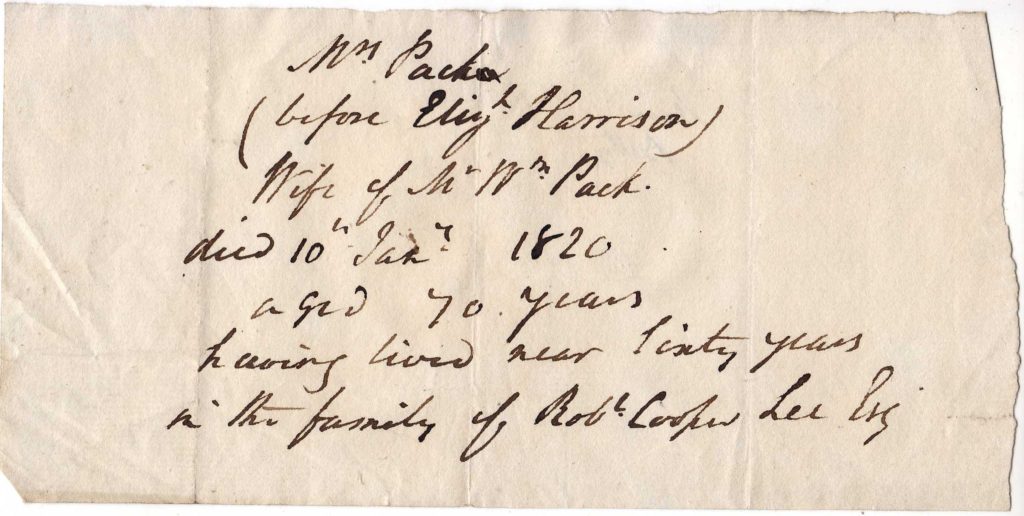Only relatively recently have many people in Britain become aware that the presence of black and mixed race people did not begin with the arrival of the Windrush in 1948. Indeed we also forget that the ship was called the Empire Windrush reflecting a heritage that was already on the wane.
Most people are still unaware of a black presence that goes back to Roman times and that increased in numbers during the eighteenth century. There are sometimes protests when a black or mixed race actor is cast in a historical drama by those who do not realise that this is an accurate portrayal of society at the time.
BBC Radio 4 is currently broadcasting a series of short talks on Britain’s Black Past and this reminded me of Betty Harrison, servant of the Lee family for nearly sixty years.
Had it not been for the note on a scrap of paper, shown above, I would never have known when she died or how old she was, let alone that she had married.
For those who have not read A Parcel of Ribbons I should explain that Betty Harrison travelled to England from Jamaica with the Lee family in 1771 and lived with them until her death in 1820. The entry for her burial at St Mary’s Barnes, alongside members of the Lee family who had been buried there since 1732, gave her age as 70 and her parish of residence as St Marylebone, but made no reference to her origins. Like many other black British residents her colour was invisible, and yet in the 1920s the family biographer Audrey Gamble referred to her as the Lee’s ‘black mammy’ and she was so much a part of the family as to merit burial with them rather than in London.
Elizabeth Harrison was born in Jamaica about 1750 and must have joined the Lee family at about the age of ten, probably as nursemaid to their eldest child Frances. It is impossible to be certain of her birth, but there is a baptism on 13 March 1758 in the parish of St Catherine for Thomas and Elizabeth, the children of Elizabeth Harrison a mulatto woman. There is no record of whether Betty was free or enslaved, but it seems probable that she was free.
The Lee children maintained an affectionate relationship with Betty all their lives, referring to her in their letters and bringing back presents for her from trips abroad. Robert Cooper Lee left her a life-time legacy of £20 a year, equivalent to an income of about £40,000 a year now (source: www.measuringworth.com). She had saved enough to be able to lend £30 to a Lee family member in 1804 so her circumstances were prosperous for a servant.
After the deaths of Robert Cooper Lee and his wife Priscilla their house in Bedford Square was sold and their children all set up separate homes. Betty Harrison stayed with Frances Lee who moved to Devonshire Street in Marylebone and it was probably there that Betty died in 1820.
The real mystery to me, and one I have yet to solve, is who was Mr William Pack, and when did Betty marry him? There was no mention of him in any of the Lee correspondence that I have seen and without the scrap of paper shown above (probably written by Frances Lee) I would never have known he existed.
Was he also a Lee servant? Were they married in England? When and where was he born and when did he die? And was he also of African origin? To date I have found none of the answers, but as more and more records come online I hope to one day.
Meanwhile a huge amount of work is now being done on the British people whose African origins have so far been invisible. You can read about Black British History Month here and if you are in London you can visit Black Chronicles: Photographic Portraits 1862-1948. There are also many regional events taking place helping to raise awareness of history that should be better known.


